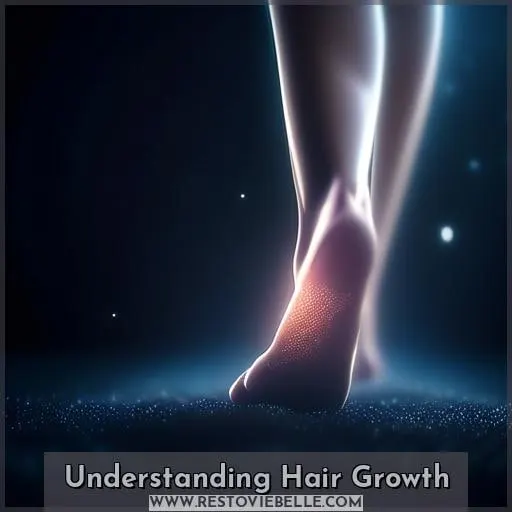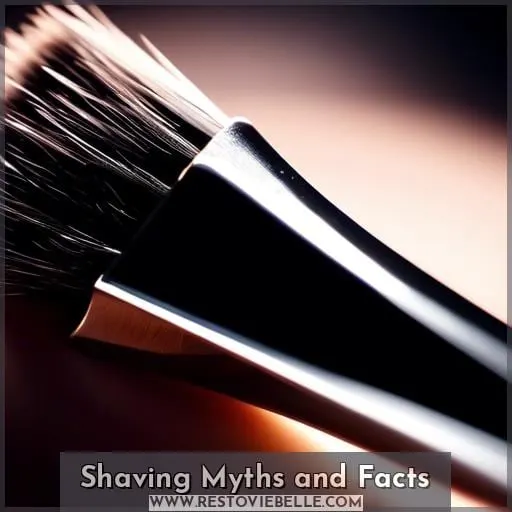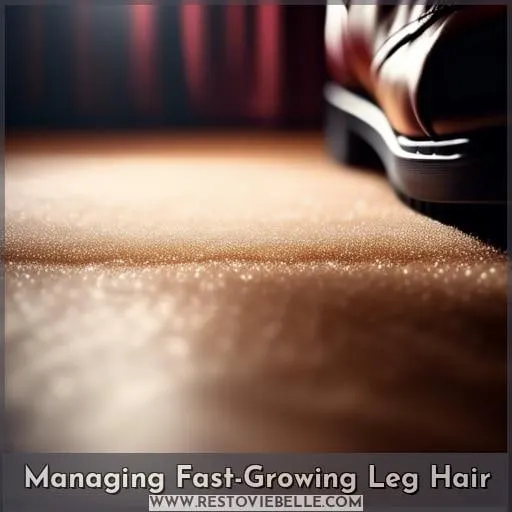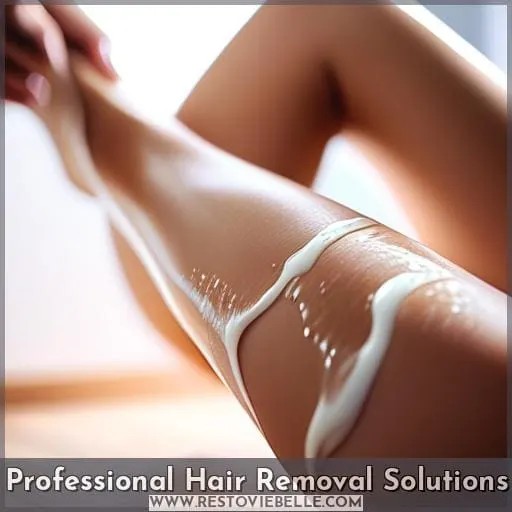This site is supported by our readers. We may earn a commission, at no cost to you, if you purchase through links.
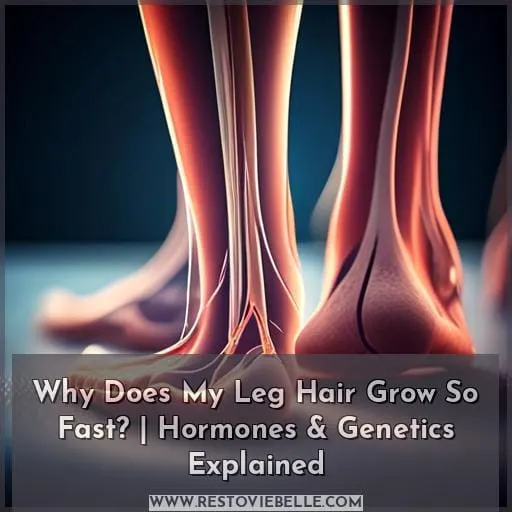 Ever noticed how quickly your leg hair seems to sprout back after shaving? You’re not alone in this hairy predicament. The speed at which your leg hair grows can be influenced by a mix of genetics, hormones, and even your lifestyle.
Ever noticed how quickly your leg hair seems to sprout back after shaving? You’re not alone in this hairy predicament. The speed at which your leg hair grows can be influenced by a mix of genetics, hormones, and even your lifestyle.
From the role of testosterone and estrogen in hair growth to the impact of stress and diet, various factors contribute to how fast your leg hair grows. Plus, we’ll debunk some common myths about shaving and explore both temporary and long-term solutions for managing fast-growing leg hair.
Whether you’re curious about the science behind hair growth or seeking ways to keep your legs smoother for longer, this guide has got you covered.
Yes, the rapid growth of leg hair can be influenced by hormones and genetics. Hormonal imbalances and genetic predispositions are key factors in determining hair growth rate and density.
Table Of Contents
- Key Takeaways
- Understanding Hair Growth
- Genetic and Hormonal Influences
- Environmental and Lifestyle Factors
- Shaving Myths and Facts
- Managing Fast-Growing Leg Hair
- Professional Hair Removal Solutions
- Frequently Asked Questions (FAQs)
- Can changing my diet significantly slow down the rapid growth of my leg hair?
- Is there a specific age at which leg hair growth begins to slow down or speed up, and does this vary significantly between individuals?
- How does the psychological stress impact the rate of leg hair growth, if at all?
- Are there any non-hormonal medical treatments available that can reduce the speed of leg hair growth?
- Can certain exercises or physical activities influence the rate of leg hair growth due to increased blood flow or other factors?
- Conclusion
Key Takeaways
- Genetics play a significant role in determining the rate of leg hair growth, as well as hair color, texture, and thickness.
- Hormonal factors, including the natural production of androgens and estrogens, can stimulate hair follicles and lead to faster hair growth on the legs and other body parts.
- Environmental and lifestyle factors, such as diet and stress, can also impact hair growth and overall hair health.
- While shaving does not cause hair to grow back thicker or faster, proper shaving techniques can help reduce skin irritation and ingrown hairs.
Understanding Hair Growth
You might be wondering why your leg hair seems to grow back so quickly after shaving. The truth is, your leg hair growth is influenced by a cycle consisting of different phases: anagen, catagen, and telogen.
During the anagen phase, your hair is actively growing, and this can last for several weeks. After that, the hair enters the catagen phase, a transitional period, and finally, the telogen phase, where the hair rests before eventually falling out.
This cycle ensures continuous hair growth, but factors like hormones and genetics play a significant role in the speed and thickness of your leg hair.
Hair Growth Cycles
Understanding the hair growth cycle is crucial for mastering the dynamics behind your leg hair growth.
-
Anagen Phase (Growth Phase): This is when your leg hair is actively growing. It can last from a few weeks to several months, but typically, leg hair has a shorter anagen phase compared to scalp hair. This phase determines the length of your hair.
-
Catagen Phase (Transition Phase): A brief period where hair growth slows down and the hair follicle shrinks. It’s a transitional stage that prepares the hair for its resting phase.
-
Telogen Phase (Resting Phase): During this phase, hair growth stops, and the hair remains in the follicle until it’s pushed out by the growth of a new hair in the anagen phase.
Factors like genetics, hormonal imbalances, and even your diet can influence these phases, affecting hair texture, thickness, and color. Understanding these cycles can guide you in choosing effective hair removal methods and adjusting your shaving frequency for better control over leg hair growth.
Anagen, Catagen, and Telogen Phases
Your leg hair grows through a fascinating process involving several stages, each influenced by your unique genetic makeup and hormonal balance.
The anagen phase is when your hair actively grows, and it can last several years, depending on the type of hair and where it’s located on your body.
The catagen phase is a transitional period where growth slows and the hair follicle shrinks.
Finally, the telogen phase is a resting stage that spans around 3 months, during which the hair doesn’t grow but remains in the follicle until it’s eventually shed during the exogen phase.
Understanding these phases can help you manage your body hair growth and explore hair removal options that work best for you.
Genetic and Hormonal Influences
You might be wondering why your leg hair seems to grow at a rapid pace.
Genetics play a crucial role in determining the rate, color, texture, and thickness of your hair.
Additionally, hormones like androgens have a significant impact, stimulating hair growth and influencing its characteristics.
These biological factors are key to understanding why your leg hair grows the way it does.
Role of Genetics
Your leg hair growth is significantly influenced by your genetics, which determine not just the color and texture of your hair, but also how quickly it grows.
- Genetics: Your genes are the blueprint for your hair follicles, influencing their behavior and characteristics.
- Hair Thickness: Genetic predisposition affects the diameter of each strand, contributing to overall hair thickness.
- Follicle Sensitivity: The sensitivity of your follicles to hormones like androgens can be inherited, impacting hair growth patterns.
- Hair Growth Disorders: Conditions like PCOS can lead to excessive hair growth, and genetics can play a part in your susceptibility to such disorders.
For those seeking solutions, options like electrolysis, laser hair removal, and IPL hair removal offer long-term results, with services available at places like Indianapolis electrolysis hair removal centers.
Impact of Hormones
Hormones play a pivotal role in the speed and pattern of your leg hair growth. If you’re noticing your leg hair seems to grow unusually fast, it could be due to hormonal imbalances.
Androgens, such as testosterone, are known for encouraging thicker and coarser hair, particularly in areas sensitive to these hormones. On the flip side, estrogen levels, which tend to decrease after menopause, can also influence hair growth characteristics.
Conditions like hypothyroidism or hyperthyroidism can further affect this growth. While genetics set the stage, it’s these hormonal factors that can either accelerate or slow down the process, making it challenging to control or stop body hair growth without addressing the underlying causes.
Environmental and Lifestyle Factors
You might be wondering why your leg hair seems to grow back so quickly after shaving.
It’s not just about your genetic makeup; your daily habits and environment play a significant role too.
Your diet and how you handle stress can both have a profound impact on the health and growth rate of your hair.
Diet and Nutrition
Your diet plays a crucial role in maintaining the health and growth rate of your hair. Proper nutrition can support the hair growth cycle and even help in prolonging freshly shaved legs.
- Incorporate protein-rich foods like eggs and fish to supply the building blocks for hair.
- Add omega-3 fatty acids from flaxseeds or walnuts for a healthy scalp.
- Vitamins A and C from sweet potatoes and citrus fruits are essential for hair health.
- Iron and zinc found in spinach and pumpkin seeds aid in hair growth.
- Stay hydrated and limit sugary foods that can hinder hair health.
Stress and Health
Just as your diet can impact the health and growth of your hair, stress and overall health are also significant factors. Stress can trigger a type of hair loss called telogen effluvium, where hair follicles enter a resting phase, potentially leading to shedding and slower growth.
Your health, including any medical conditions or medications, can influence hair growth as well, with conditions like PCOS and thyroid dysfunctions being notable examples.
Here’s a snapshot of how various factors can affect your leg hair growth:
| Factor | Influence on Hair Growth | Control Level |
|---|---|---|
| Stress | Can induce hair loss and affect growth cycles | Moderate (stress management techniques can help) |
| Diet | Nutrient deficiencies can lead to hair loss | High (a balanced diet can promote hair health) |
| Health | Medical conditions like PCOS can increase hair growth | Low to Moderate (depends on treatment options) |
| Environment | Pollution and toxins can damage hair follicles | Moderate (lifestyle changes can mitigate effects) |
| Genetics | Largely dictates hair growth rate and pattern | Low (inherent and not modifiable) |
Understanding these factors can empower you with knowledge and strategies to manage your leg hair growth effectively. Remember, while you can’t change your genetics, you can influence other factors like stress and diet to potentially slow down how fast your leg hair grows.
Shaving Myths and Facts
You might’ve heard that shaving can cause your leg hair to grow back thicker or faster, but this is actually a myth.
Shaving cuts the hair at the surface of your skin, and while the stubble that grows back may feel coarser, it’s not actually thicker. Your hair’s growth rate and thickness are determined by genetics and hormones, not by your razor.
So, when you notice your leg hair growing quickly after shaving, it’s simply following its natural cycle, not responding to the act of shaving itself.
Shaving Techniques
You’ve been keeping up with your diet and managing stress, which are great for your overall health and can even impact hair growth. Now, let’s talk about shaving techniques, which can make a big difference in how your legs feel post-shave.
- Razor Angle: Hold your razor at the right angle to avoid nicks and cuts. A slight angle is usually best to get a close shave without irritating the skin.
- Shaving Frequency: Don’t overdo it; shave every two to three days to maintain smoothness without causing irritation.
- Shaving Cream: Use a quality shaving cream to protect your skin and provide lubrication, which can help prevent razor burn.
- Ingrown Hairs: Shave in the direction of hair growth to minimize the risk of ingrown hairs and reduce skin irritation.
Hair Regrowth After Shaving
Contrary to popular belief, shaving doesn’t cause your leg hair to grow back thicker or faster. It’s genetics and hormones that are mainly responsible for the rate and texture of hair growth.
If you’re dealing with frequent shaving, razor burn, or ingrown hairs, consider refining your technique. Moisturizing techniques and chemical exfoliation can help maintain smooth skin and reduce irritation.
For a closer shave without the discomfort, shave in the direction of hair growth and use a sharp blade to minimize razor burn and ingrown hairs.
Managing Fast-Growing Leg Hair
If you’re frustrated by how quickly your leg hair seems to grow back after shaving, you’re certainly not alone. Managing fast-growing leg hair can be challenging, but there are both temporary and long-term removal methods that can help.
Let’s explore some effective strategies to keep your legs smoother for longer, and consider professional options for more permanent solutions.
Temporary Removal Methods
When it comes to managing fast-growing leg hair, you’re not alone in seeking effective and temporary removal methods.
- Shaving: It’s quick, easy, and can be done at home. Just remember, the smoothness lasts only a few days at most.
- Waxing: Offers longer-lasting results, with hair taking 2-4 weeks to grow back. It can be painful but leaves skin silky smooth.
- Depilatory Creams: These chemical-based creams dissolve hair right below the skin’s surface. They’re pain-free but watch out for potential skin reactions.
- Sugaring: Similar to waxing but uses a natural paste. It’s gentler on the skin and effective for up to five weeks.
- Threading: Best for facial hair, but can be used on legs for precise hair removal. It’s a bit time-consuming and requires skill.
Each method has its pros and cons, including cost comparison and effectiveness. Whether you’re looking for a quick fix or a longer-term solution, there’s a temporary removal method to suit your needs.
Long-Term Removal Options
If you’re considering long-term solutions for managing fast-growing leg hair, electrolysis and laser hair removal are effective options.
Electrolysis uses electric current to permanently destroy hair follicles. It can be costly, with leg treatments potentially reaching up to $10,000. While generally safe, electrolysis can cause temporary redness, swelling, and even scarring if not performed correctly.
Laser hair removal targets melanin in the hair and is most effective for those with pale skin and dark hair. It’s important to consult with a professional to determine if you’re a suitable candidate for laser treatments, as not all hair and skin types are ideal.
Both methods may require multiple sessions but offer a permanent reduction in hair growth.
When weighing sugaring vs. epilation or considering the effectiveness of electrolysis, remember that each method has its own set of long-term side effects and cost implications.
Professional Hair Removal Solutions
If you’re wondering why your leg hair grows back so quickly and looking for a more lasting solution, professional hair removal methods like laser hair removal and electrolysis could be the answer.
These techniques target the hair follicles to significantly reduce hair growth over time. While they require a series of treatments and can be an investment, many find the longer-term results well worth it.
Laser Hair Removal
Laser hair removal offers a compelling solution for those tired of regular shaving and waxing. This method uses concentrated light to target hair follicles, effectively delaying hair growth for extended periods.
While not usually permanent, it can significantly reduce hair regrowth with multiple treatments. It’s most effective for individuals with light skin and dark hair due to the contrast needed for the laser to target the melanin in the hair.
The process is generally safe with minimal recovery time, allowing you to resume daily activities swiftly, although some redness and swelling may occur. Costs average around $582, but this varies based on location and the number of sessions required.
Maintenance treatments are occasionally needed to keep the skin smooth. Always consult with a certified professional to ensure safety and effectiveness, and consider a free initial consultation to understand your options for permanent hair removal.
Electrolysis
After exploring laser hair removal, you might consider electrolysis, a method that offers permanent results.
Electrolysis works by inserting a fine probe into the hair follicle and applying an electrical current to destroy it. While the process can be slower and may require multiple sessions, the benefits of electrolysis include the ability to treat any hair color and skin type.
However, be mindful of the electrolysis cost, which can range from $30 to $100 per session, and the total expense can add up depending on the number of sessions needed. Electrolysis risks are minimal, but you may experience temporary redness or swelling.
When done correctly, electrolysis results in permanent hair removal, making it a worthwhile investment for those seeking a long-term solution.
Frequently Asked Questions (FAQs)
Can changing my diet significantly slow down the rapid growth of my leg hair?
While adjusting your diet can impact overall health, it’s unlikely to significantly slow down rapid leg hair growth.
Focus on a balanced diet for overall well-being.
Is there a specific age at which leg hair growth begins to slow down or speed up, and does this vary significantly between individuals?
Leg hair growth can indeed vary with age, becoming thinner and potentially less dense as one gets older, largely due to hormonal changes.
Imagine a young athlete, legs covered in thick, dark hair, who notices a gradual thinning over decades.
This change is normal and varies significantly between individuals due to factors like genetics and overall health.
How does the psychological stress impact the rate of leg hair growth, if at all?
Psychological stress can indeed affect your leg hair growth. It can cause hair follicles to prematurely enter the resting phase, leading to hair loss or slower growth.
Are there any non-hormonal medical treatments available that can reduce the speed of leg hair growth?
Yes, there are non-hormonal medical treatments available to reduce the speed of leg hair growth. These include laser hair removal and electrolysis, which target hair follicles to slow down or stop hair growth.
Laser hair removal uses concentrated light to damage hair follicles, while electrolysis involves using electric current to destroy them. Both methods may require multiple sessions for optimal results and are considered more permanent solutions compared to temporary hair removal methods like shaving or waxing.
Can certain exercises or physical activities influence the rate of leg hair growth due to increased blood flow or other factors?
Yes, certain exercises can influence the rate of leg hair growth by improving blood circulation and reducing stress.
Regular aerobic activities like jogging and yoga boost blood flow and oxygen to hair follicles, potentially extending the growth phase of hair.
Additionally, exercise-induced stress reduction can prevent hair thinning.
Conclusion
Navigating the lush forest of leg hair growth can feel like a journey through a mystical land, where hormones and genetics are the reigning forces, shaping the landscape.
If you’ve ever wondered why your leg hair grows so fast, it’s essential to recognize the powerful role that genetics and hormones play in this process. Your body’s unique hormonal blueprint, influenced by factors like testosterone and estrogen, orchestrates the symphony of hair growth.
Meanwhile, your genetic heritage whispers secrets of hair density and speed of growth passed down through generations.
But fear not, for this journey also reveals paths to manage this verdant growth, from temporary solutions that clear the underbrush to long-term strategies that alter the terrain. Embrace your body’s natural rhythms, and remember, you’re not alone in navigating this wild, hairy world.

